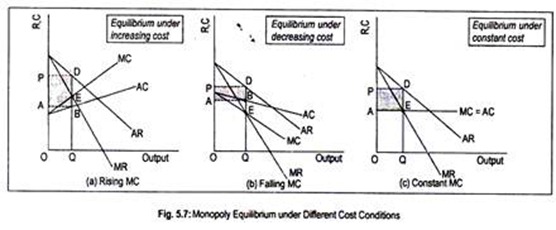ADVERTISEMENTS:
i. MC = MR
ii. Slope of MC > slope of MR
Under increasing cost, monopoly equilibrium, just like perfect competition, is possible. In this case, MC and AC curves are rising. In Fig. 5.7(a), E is the equilibrium point since both FOC and SOC are fulfilled at this point. The monopoly firm gets supernormal profit to the extent of ABDP by selling OQ output at the price OP.
 If the monopoly firm operates under decreasing cost, it’s MC and the AC curves must be falling. Because of the fulfilment of FOC and SOC for equilibrium, the monopolist earns supernormal profit to the tune of ABDP.
If the monopoly firm operates under decreasing cost, it’s MC and the AC curves must be falling. Because of the fulfilment of FOC and SOC for equilibrium, the monopolist earns supernormal profit to the tune of ABDP.
ADVERTISEMENTS:
Under constant cost condition, MC curve becomes horizontal and coincides with the AC curve. Point E is the equilibrium point since, at that point, not only MC = MR but also the slope of MC > slope of MR. Anyway, the monopolist earns supernormal profit of AEDP amount by selling OQ output. This situation is incompatible with equilibrium under perfect competition.
So we can conclude that a monopolist may reach equilibrium under any cost conditions. He will attain equilibrium even if MC is falling or constant.